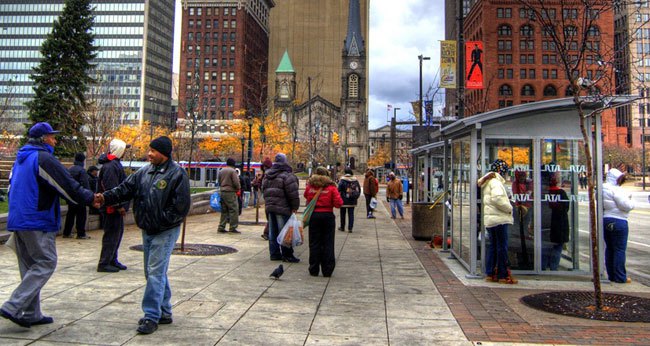Cleveland Mayor Frank Jackson has closed off his downtown's recently redesigned Public Square to buses, leading to painful delays for riders and higher costs for the region's already struggling transit agency. The Jackson administration claims that keeping buses out of the square reduces the threat of terrorism (which clearly doesn't stand up to scrutiny), while critics point to a simpler explanation: The mayor is caving to business interests who object to the presence of bus riders.
Jarrett Walker, a transit consultant who blogs at Human Transit, says he's seen this situation before, and he has a message for the business leaders who want to push bus riders to the margins:
In the course of transit planning work in several US cities, I’ve been quietly taken aside by a downtown business leader and told that of course those ugly buses have to be gotten off of the main street, and put out on some back street where the loading docks are. And sadly, I have sometimes been told the same by advocates of public space, often credentialed New Urbanists, who insist that their aesthetic disapproval of the bus should outweigh people’s need for useful, reliable transit service. Most of these latter group don’t really understand the impact of those comments, but I see their impacts everywhere.
Now and then someone makes the class-segregation narrative explicit. For example, in one US city where I worked years ago, a downtown business leader explained to me that “those people” waiting for buses on the main street were deterring customers from visiting businesses, and “making people feel unsafe.” The candor was refreshing: the problem isn’t the buses. The problem is unwanted people who do not deserve to be respected by the design of the city -- including, of course, many of the business community’s own employees.
This leader also assured me that women would never feel comfortable walking through these crowds -- contrary to the view of professional women who were working with us on the project. The stops in question did have a lot of people waiting at them. Like any busy place they attracted the usual diversity of urban characters, including street preachers, small scale salesmen, and self-styled performing artists, and perhaps one or two petty criminals. But people are rarely attacked in the middle of largely law-abiding crowds.
This problem actually had an easy solution. Robust real-time information, available by text and voice as well as in smartphone apps, encourages people to come to the stop only a few minutes before their bus leaves. Bus stops have become noticeably less crowded in communities that have rolled these out, as you would expect. That also means, business leaders, that people waiting for the bus have more time to patronize nearby businesses.
But in that instance, the business community’s solution was to move the buses onto a deserted street where nobody would see them, and also to “spread buses out” so that no stop would be as busy. This would solve the problem of the "feeling of safety" by creating a problem of actual safety. Bus riders would have to walk to an isolated street and wait in a place with fewer eyes to witness crimes against them. And of course, the other effect would be to make the transit system less attractive, so that fewer people with choices would use them. Connecting from one bus to another, for example, would be harder to figure out and require longer walks.
In many cases, Walker writes, businesses use transit riders as scapegoats when things aren't going well. Mayors would be wise to ignore those complaints and "welcome the buses and their passengers."
More recommended reading: Greater Greater Washington makes the case for covering blank walls with public murals. And Plan Philly reports on the confusion surrounding the Trump administration's infrastructure objectives, including an executive order that supposedly expedited the environmental review process for certain projects.





